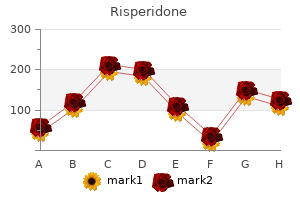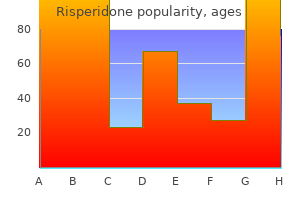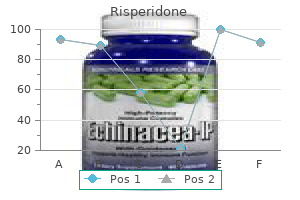

"Purchase 3 mg risperidone with visa, treatment 3rd degree hemorrhoids".
P. Ateras, M.B. B.CH. B.A.O., M.B.B.Ch., Ph.D.
Co-Director, Washington State University Elson S. Floyd College of Medicine
For refractory/relapsing disease kinase inhibitors may be beneficial in some patients symptoms you may be pregnant cheap risperidone 4mg otc, but further trials are awaited symptoms juvenile diabetes purchase 3 mg risperidone fast delivery. Thyroglobulin levels serve as a useful tumour marker following total thyroidectomy 2d6 medications risperidone 4mg sale. Slow growing Local spread to cervical lymph nodes is common at presentation administering medications 7th edition ebook order risperidone 3mg free shipping, but distant metastases are rare Follicular thyroid cancer $1015% of all cases <:, $1: 23. Total thyroidectomy may be curative in the early stages hence the rationale for genetic screening of relatives (Continued) 215 216 Table 16. Aggressive Typically presents with painful, rapidly expanding thyroid mass, which infiltrates local tissues and hence does not move on swallowing. Knowledge of the anatomy and physiology of the hypothalamus and pituitary helps to understand the different presentations of patients with sellar and parasellar lesions. In essence, pituitary disorders typically present with one or more of the following. Pituitary adenomas and hypopituitarism the term hypopituitarism denotes an insufficiency of one or more of the anterior or posterior pituitary hormones. Interestingly, prolactin insufficiency is rare in this setting and indeed the lactotrophs are remarkably resistant to pressure effects, such that prolactin levels often rise as the tonic inhibitory control of dopamine is lost due to stalk compression. In contrast, vasopressin and oxytocin are transported along axonal projections from the hypothalamus to the posterior pituitary and stored in vesicles prior to release. Negative feedback at the level of the pituitary and hypothalamus is mediated via hormones secreted by target organs (shown in italics). Aetiology Destruction/compression of the normal pituitary tissue or reduction in the blood supply (including the hypothalamicpituitary portal circulation) accounts for the majority of cases of hypopituitarism (Table 16. Aside from a small number of genetic cases, the factors underlying pitutary adenoma formation remain poorly understood. In the majority of cases patients present with features of one or more of hormone hypersecretion, hormone hyposecretion or local mass effects, as outlined above. Hyperprolactinaemia per se is associated with reduced libido in both sexes and galactorrhoea in females. In addition, however, even in the presence Clinical presentation this is variable and depends on not only the aetiology but also the extent of endocrine dysfunction and the Endocrine disorders 219 Table 16. Accordingly, oligomenorrhoea/ amenorrhoea in females and erectile dysfunction in males are commonly encountered. It is important to note, however, that hyperprolactinaemia is not always caused by a prolactinoma. Local mass effect(s) In addition to compression of the normal pituitary gland, sellar/parasellar lesions may cause compression of the optic chiasm, resulting initially in a superior quadrantic bi-temporal field defect (signifying pressure on the underside of the chiasm), which ultimately progresses to a complete bitemporal hemianopia. Third, fourth and sixth cranial nerve palsies are relatively rare even with lateral tumour extension, but may be seen with infiltrative lesions or if there is rapid expansion of a tumour, for example following haemorrhage, as occurs in pituitary apoplexy. Investigation Again, for ease of memory, the investigation of pitutiary disorders can be considered under the headings Endocrine disorders 221 Figure 16. Normal subjects suppress serum cortisol to < 50 nmol/l in both dexamethasone tests. Hormone hypersecretion Hyperprolactinaemia Wherever possible the confounding effects of medications and other disorders. Treatment Hormone hypersecretion Prolactinomas (both micro- and macro-adenomas) are usually treated with medical therapy with a dopamine agonist. In cases where there is incomplete tumour resection, adjunctive radiotherapy may be considered,dependingontheextentofresidualtumour, threat to neurological structures. For secretory tumours medical therapy may be used, while the beneficial effects of radiotherapy are awaited. Cortisol hypersecretion can be controlled with metyrapone or ketoconazole (which block adrenal steroid biosynthesis). Pre-operative control of hypercortisolism is important to reduce operative risk and post-operative complications.


Hypomania is similar to a manic episode except there is no impairment to the patient in any of their day-to-day functioning medicine 20 buy 3mg risperidone free shipping. Patients with personality disorders do not seek help for their disorder because they are not aware that they are the cause of their own problems symptoms zenkers diverticulum buy risperidone 2 mg without a prescription. Schizoid this patient will have a long history of voluntarily avoiding social situations medicine 1800s buy discount risperidone 2 mg on-line. Schizotypal this patient has an odd/peculiar appearance symptoms juvenile diabetes cheap 3 mg risperidone free shipping, has magical thoughts and an odd pattern of behavior. Narcissistic this patient has a sense of entitlement and lacks empathy for others. Antisocial this patient refuses to accept the rules of society, shows no concern for their own actions, and shows no remorse for bad behavior. Borderline this patient has erratic behavior, impulsiveness, and mini psychotic episodes. Obsessive-Compulsive this patient is a perfectionist, orderly, stubborn, and indecisive. Dependent this patient allows and wants others to make decisions for them, related to a lack of self-confidence. Phobias Specific phobias an irrational fear of specific objects, such as spiders, snakes, etc. A social phobia is an exaggerated fear of social or environmental situations (the most common social phobia is public speaking). Management is desensitization, can use beta-blockers for short-term control of autonomic symptoms. Generalized Anxiety Disorder Patient experiences persistent symptoms of anxiety for at least 6 months. Post-Traumatic Stress Disorder Is a condition that affects someone who has been through a catastrophic event (classically a war veteran). Those with this condition are not malingering, are not delusional, and truly believe they have a physical problem. Conversion Disorder Patient experiences an abrupt, dramatic loss of motor or sensory function. Most commonly the patient experiences paralysis, seizures, paresthesias, anesthesias, and visual problems. Hypochondriasis these patients have an exaggerated concern that they have illnesses despite being told repeatedly that there is no cause for concern. Body Dysmorphic Disorder the patient has an excessive and possibly obsessive focus on a minor or possibly imagined physical defect. Pain Disorder Pain that is not explained by any physical problem, often co-exists with another medical problem. If lasting < 6 months, it is an acute pain disorder, if lasting > 6 months it is a chronic pain disorder. Factitious Disorders Somatization disorder Conversion disorder Hypochondriasis Body Dysmorphic disorder Pain disorder Undifferentiated Somatoform disorder A patient with factitious disorder consciously creates their symptoms in order to assume the role of the sick patient so they can get medical attention (the motivation however is unconscious). Malingering Disorders Patients with malingering disorder consciously simulate or exaggerate a physical or mental illness for an obvious gain (Money, Care, Avoidance of work). Awake with eyes open Beta waves, serotonin stimulates the rape nuclei to induce sleep Awake with eyes closed Alpha waves Stage 1 this is the stage of "light sleep". This stage is short, lasting approximately 5% of all sleep time, Theta waves are predominant. Anterograde this person will be unable to remember anything after occurring after the incident that caused their amnesia, therefore they cannot form any new memories. Retrograde this person will be unable to remember things that occurred before the causative factor of their amnesia. This may last from a few seconds to minutes, and may occur up to 30 times per hour. Obstructive sleep apnea this type of apnea is usually caused by excessive weight, which causes obstruction and physical blockage of breathing.

There is also goblet cell metaplasia/hyperplasia and multiple glands distended with amphophilic (mucous) secretion medicine zetia purchase 4 mg risperidone with visa. The inflammation extends along and multifocally infiltrates degenerate trigeminal nerves medicine 9312 buy cheap risperidone 2mg on-line, and results in necrosis of approximately 10% of the right cerebral hemisphere treatment plan template buy cheap risperidone 2mg. Adjacent to the necrotic regions in the brain medications 8 rights purchase 3 mg risperidone fast delivery, multifocal areas of neuropil are rarefied (malacia). Within the right lateral and the third ventricles of the brain, there are small numbers of neutrophils, macrophages, lymphocytes, and plasma cells. Multifocally and primarily at the edges of the foci of necrosis in the tympanic cavities and in the brain there are colonies of gram-negative rodshaped and gram-positive coccoid bacteria. The inflammatory process also involves the laryngeal submucosa and skeletal muscle, resulting in myofiber necrosis characterized by hyalinization and fragmentation. The intracranial bone marrow appears hypercellular, with moderate myeloid hyperplasia. Skull, rat: There was extensive remodeling and enlargement of the tympanic bullae. Abscesses are seen within the left bulla and the right ventral hippocampus (arrows). Left tympanic bulla, rat: the inflammatory infiltrate results in remodeling and multifocal resorption of the temporal bone. Although not evident in the current case, concurrent otitis interna was strongly suspected due to extension of the inflammatory process into the brain. Otoscopic examination may reveal an inflamed tympanic membrane, pus behind the membrane, or membrane rupture. Organisms commonly implicated in otitis media in rats are Mycoplasma pulmonis, Streptococcus pneumonia, Pasteurella pneumotropica, Staphylococcus sp. Prevotella melaninogenica (formerly Bacteroides melaninogenicus) is an anaerobic gram-negative bacillus. Of the anaerobic gram-negative bacilli involved in animal diseases, Fusobacterium is the most important genus, and other genera include Bacteroides, Dichelobacter, and Porphyromonas. Brain: Meningoencephalitis, suppurative, focally extensive, with neural degeneration. Middle ear: Otitis media, suppurative, focally extensive, with mucosal ulceration, squamous metaplasia, and bone remodeling. External ear canal: Otitis externa, ulcerative, focally extensive, chronic-active. It is likely the initial insult was bacterial colonization within the nasopharynx that spread up the Eustachian tube to the middle ear followed by its extension into the calvarium. Of special importance here is the formation of a cholesteatoma within the middle ear. Cholesteatomas are common in people in this geographic location, usually associated with chronic otitis media. They are nonneoplastic, cystic lesions lined by keratinizing squamous epithelium or metaplastic mucussecreting epithelium and filled with amorphous debris. With the common occurrence of ear infections in infants and children, there is an extensive amount of published information regarding their pathogenesis and treatment in people, most of which revolves around the formation of biofilms. Biofilms are complex bacterial communities that adhere to the surface of implanted biomaterial or mucosa and play a major role in chronic ear infections. This is why the first choice of treatment with internal ear infections in people is often surgery, and why all tissue with potential to harbor biofilms must be removed at that time or risk recurrence of infection. Nomenclature aside, appropriate function of the ear requires vibration of the tympanic membrane by sound waves, which are then conducted into the cochlea via the ossicles of the middle ear 4 (malleus, incus and stapes) by a push on the oval window. This movement incites a fluid wave within the cochlea, which is completely full of lymph fluid called endolymph. Where along the snail-shaped cochlea this wave intersects with the Organ of Corti and subsequently delivers information to the brain depends on its frequency. Of vital importance to this conduction system is the maintenance of a strong positive endocochlear potential within the endolymph, which requires precise control and recycling of potassium. In fact, potassium recycling defects in the cochlea is an important cause of deafness in people. The role of anaerobic bacteria in chronic suppurative otitis media in children: Implications for medical therapy.

Syndromes
Oleandrin produces changes in intracellular calcium levels in isolated cardiomyocytes: A realtime fluorescence imaging study comparing adult to neonatal cardiomyocytes treatment arthritis effective risperidone 2 mg. The first calf died in September medicine x boston risperidone 2mg fast delivery, just before weaning and had shown bloody diarrhea that did not respond to treatment with oxytetracycline medications used to treat migraines buy discount risperidone 2 mg line. It was submitted for necropsy to the Washington Animal Disease Diagnostic Laboratory at Washington State University administering medications 8th edition risperidone 3mg generic. Gross Pathology: Multifocally, throughout the jejunum, ileum, cecum, and colon, were widely scattered, linear to elliptical areas of mucosal ulceration that ranged from 0. The edges of the ulcers were raised and there were multifocal areas of hemorrhage within the surrounding mucosa. Other minor lesions included mesenteric lymphadenopathy and mild, mucopurulent tracheitis. The ulcers were covered by large coagula composed of numerous degenerate neutrophils admixed with abundant necrotic cellular debris and mixed bacterial colonies. Remaining crypts in the adjacent, less severely affected mucosa, were mildly to markedly ectatic and filled with abundant mucus admixed with necrotic cellular debris and many degenerate 4-1. Ileum, calf: There are multifocal elliptical areas of necrosis, most prominently in the ileum. The lamina propria in these regions was moderately expanded, and crypts elevated by increased numbers of lymphocytes, plasma cells, neutrophils, and varying amounts of edema. Positive controls had appropriate immunoreactivity and a replicate slide stained with a non-specific antibody (isotype control) had no immunoreactivity in those areas. Highly virulent strains (usually type 2 genotypes) may cause acute, severe disease with high morbidity and mortality with lesions indistinguishable from mucosal disease (described later). Transiently infected or vaccinated cattle develop neutralizing antibodies that are protective against reinfection. Infected fetuses may be aborted or may develop hydrancephaly, cerebellar hypoplasia, thymic atrophy, osteosclerosis or cataracts and other ocular lesions. They shed large amounts of virus and are an important source of infection for the herd. The classic clinical presentation of mucosal disease is a small calf with oculonasal discharge and severe diarrhea. Additionally, there are reports of disease in other species to include white-tail deer, sheep, goats, mouse deer, mountain goats and alpacas. Eradication efforts have been underway throughout Europe and in areas within the U. The difference between cp and ncp strains was demonstrated in vitro as the ability to induce apoptosis in bovine turbinate cells. Bovine viral diarrhea virus infections: Manifestation of infection and recent advances in understanding pathogenesis and control. Review of the Michigan Upper Peninsula bovine viral diarrhea virus eradication project. Seroprevalence of bovine viral diarrhea virus in alpacas in the United States and assessment of risk factors for exposure, 2006-2007. Reverse transcription-polymerase chain reaction on pooled samples to detect bovine viral diarrhea virus by using fresh ear-notch supernatants. History: the kitten reportedly developed pale, unformed stools, anorexia, rapid weight loss and death within 2 weeks of purchase from a pet store. The owner of the pet store reported that multiple kittens both living at the store and recently purchased from the store had developed similar clinical signs, with most of the affected kittens recovering after supportive treatment. In addition, two apparently well-grown kittens had died suddenly within the previous 2 months. Gross Pathology: the kitten presented within 12 hours of death and was judged to be in an adequate state of post-mortem preservation, in very poor body condition (315g) and moderately dehydrated. Liver, kitten: Multiple foci of necrosis are infiltrated by low numbers of neutrophils. Liver, kitten: Filamentous bacilli consistent with Clostridium piliforme are present within hepatocytes and extracellularly within necrotic foci. Hepatocytes around the margins of necrotic foci are often swollen with vesicular nuclei and vacuolated cytoplasm (degenerate). Moderate numbers of neutrophils, macrophages and fewer lymphocytes separate foci of necrosis from the surrounding normal hepatic parenchyma. Smaller foci of similar inflammatory cells without significant central necrosis are also scattered throughout.